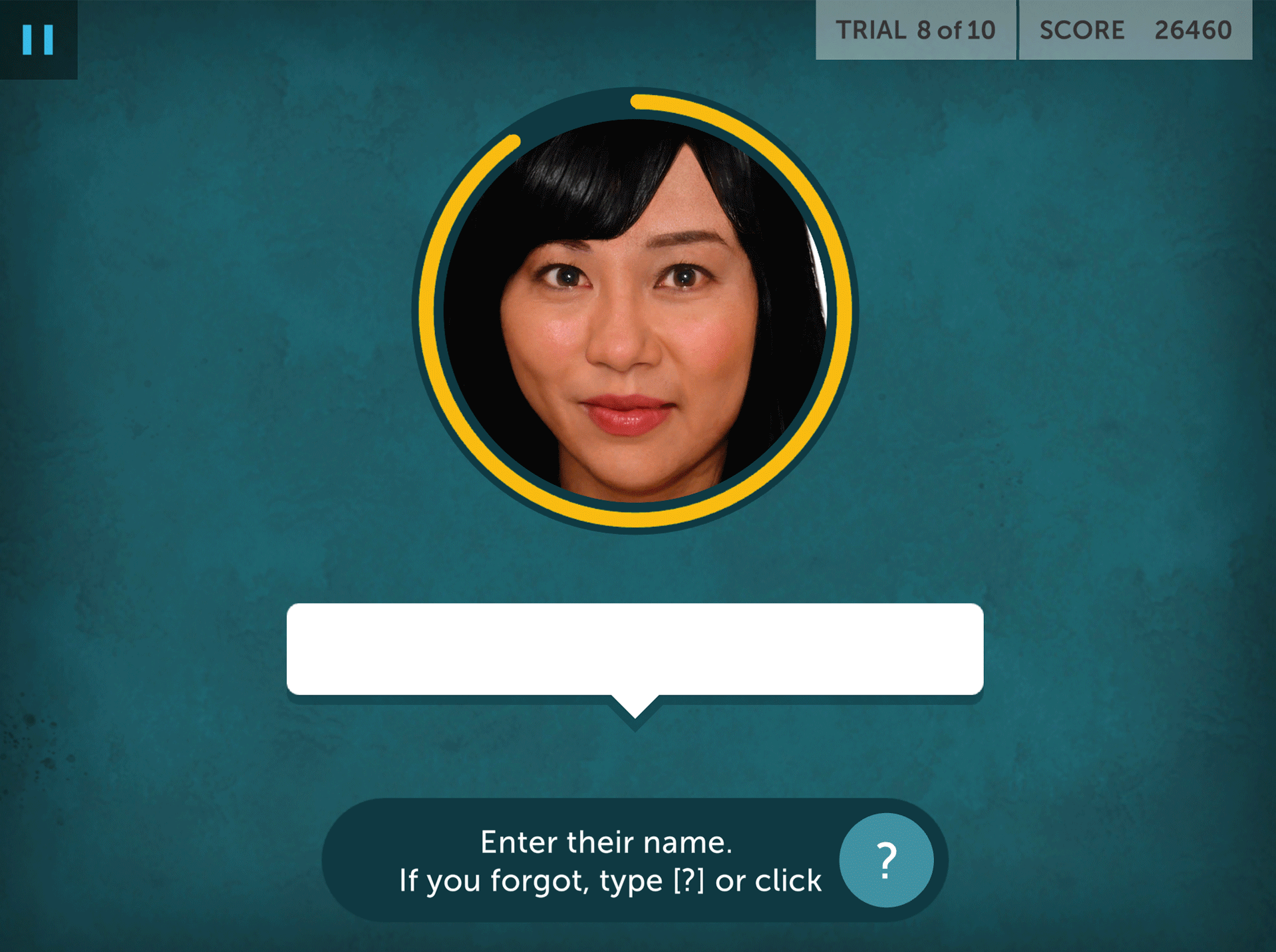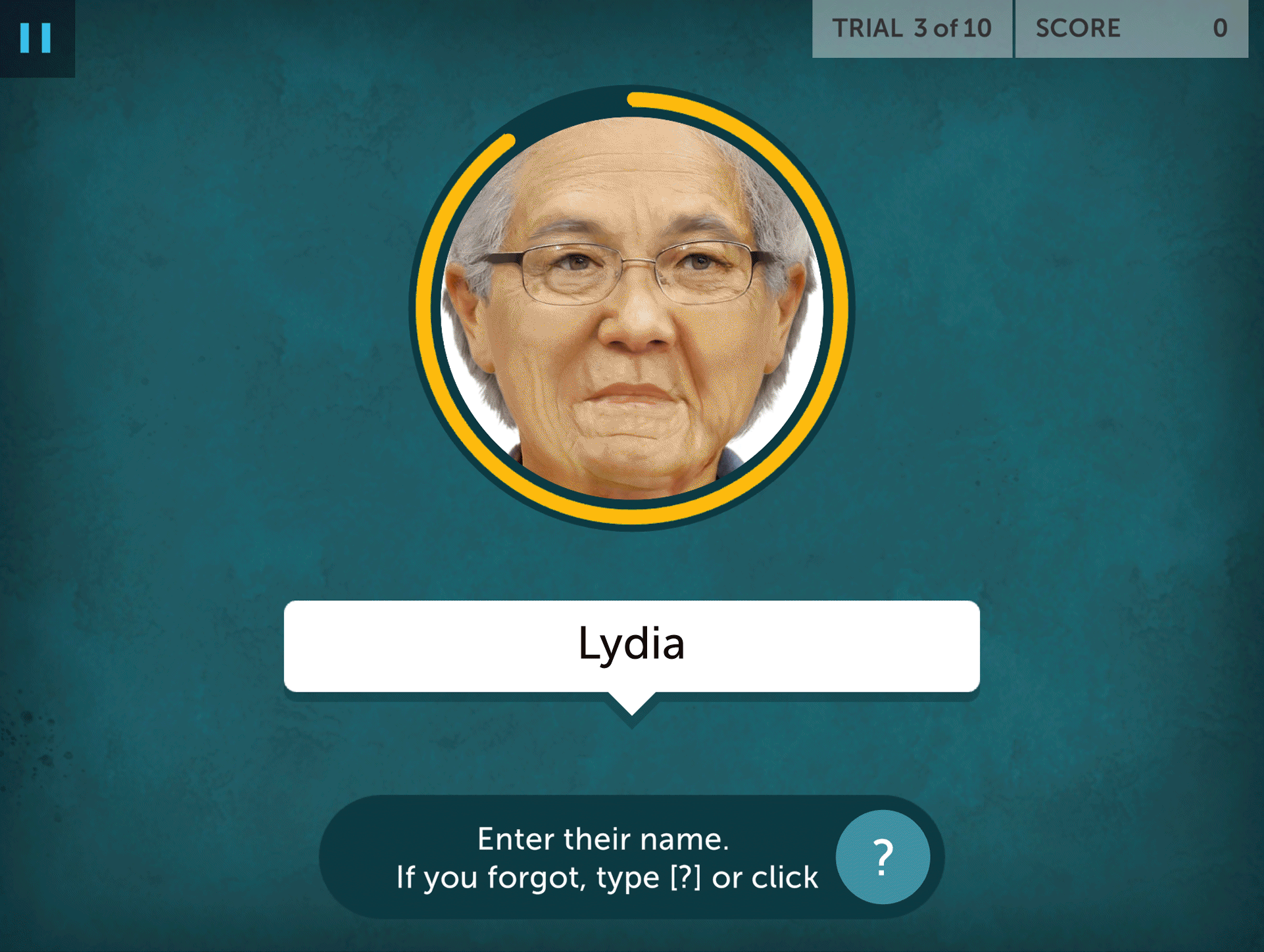
What’s My Name? - The NEW game for remembering names and faces
We all know the feeling of frustration and embarrassment when we forget the name of someone we’ve just met, or worse, someone we’ve met more than once. Moments like these are often the reason why people want to train their Memory. Indeed, Memory is the number one brain area that Lumosity members express interest in training. And, understanding the profound importance of making and maintaining personal connections, many of us put names at the top of the list for what we’d like to remember better.

Enter What’s My Name?, our latest creation designed to help you practice memorizing faces and the names that go with them. Keep reading to learn more about how the game works, how it was designed, and most importantly - strategies you can apply to remembering names, both in the game and in real life.
How does it work?
What’s My Name? presents a challenging blend of tests to your short-term and long-term Memory. As you play, virtual characters will introduce themselves and share facts about themselves or personal interests. Your task, of course, is to remember their names.

As the game progresses, the same faces will resurface, prompting you to recall their names. Accurate responses will earn you points, and swift responses will maximize your score. Stuck? No worries! You can either take a guess, or simply ask for their name by clicking a question mark at the bottom of the screen. Similar to reality, you won’t score any points when you ask for their name, and you may be (gently) scolded by the character, but thankfully none of your real-life relationships will suffer. The real kicker though, is that each gameplay will quiz you on names from your previous session while also introducing new virtual acquaintances. That’s where Long-term Memory comes into the mix.
This integration of Long-term Memory into a Lumosity game is a rare and unique challenge within our library of Memory games, and perfectly suited for the skill of remembering names.

Game Design: Where art, science, and practicality meet
To maximize the practical applications of this game, we wanted to mimic real-life scenarios as much as possible. Some of this was accomplished in the theming and game mechanics. For example, we incorporated the sounds of people chatting in the background and added conversational exchanges to each encounter with our characters. Pro-tip: each of these conversational moments doubles as a natural mnemonic aid, whereby what we know about a person can help us remember them.
Rather important to the game’s design was the selection of faces themselves. In addition to the practicality we knew our members would want in this game, we wanted to ensure it was engaging and maximally challenging for everyone. When it came to the faces, this meant they would need to be photo-realistic, diverse, and expressive. Let’s break each of those down for a moment:
Photo-realism: Not only does this bring the game closer to reality, but research across psychology and neuroscience has shown that facial recognition and recall rely on nuanced details that may not be fully captured by cartoon faces.
Diversity: Both our members and the people they meet will vary in age, skin tone, and gender expression. Further, past studies have shown that our Memory for faces can be influenced by such factors (1), so variety along these traits would equalize the challenge for all players.
Expressiveness: This element adds not only an engaging quality to the game, but captures our goal for realism and practicality. The faces of people we meet are rarely static, and it may be harder to recognize them when making certain expressions.
Finally, we wanted to reserve an easy path for expanding our library of faces and names in the future.
To meet all those criteria, our pursuit of engaging realism led us ironically to an artificial solution: Artificial Intelligence (AI). That’s right, none of the faces you’ll meet in What’s My Name are those of actual living humans. Instead, each face is merely a collection of pixels generated by artificial intelligence to simulate a human face making a handful of different expressions. Ultimately, this solution gave us the quantity, diversity, and room-to-expand that we were looking for.

Next came the names. Again, we wanted to balance diversity with familiarity. This was no easy feat given that diversity and familiarity are entirely relative, varying based on someone’s location and cultural background. After a lot of research and consideration, our team found a list of names that were not just common, but common across more than one ethnic group (2). See our references at the bottom to learn more about this source.

To bring it all together, the names, backstories, and faces are paired together at random for each and every Lumosity member that plays. As a result, everyone who plays will get a different experience. That face which, for you, belongs to Stella who studies chemistry, might for me be Sue, the History Teacher.
Finally, there’s scoring. Given the task at hand, this game’s scoring system rewards you primarily for remembering the name itself, with a bonus given to you for speed. Potential points for each game increase as you meet more characters. As far as accuracy is concerned, the scoring is designed to be a bit forgiving, accepting reasonable misspellings of the name. All together, our designers thought this scoring system properly reflected the demands and rewards of natural encounters.
Pro-tips: How to remember names and faces

There’s a lot of great advice out there for remembering names and What’s My Name? is a great place to put them to the test. Here are some of our favorite strategies, and how to apply them while you play:
1. Associations and story-building:
First, look for distinct features that you’re likely to notice again the next time you see this face. Think: what was the first thing you noticed about them? Next, when someone shares a detail about themselves, try to associate that information with both their name, as well as that particular feature. Associations can be made stronger and more memorable when they are visual or tell a story. Rhyming and alliteration can also help
Example: A character named Lydia, with glasses, who works in a neon light museum. Lydia sounds like “lit up”, like a neon sign, and you can imagine the rims of her glasses glowing a neon glow. A bit of caution here though, more than one character may have glasses.

2. No rush:
Remember that the moments of introduction in this game are NOT timed. Use these moments to really absorb the name, the visuals, and narrative you want to use for remembering it.
3. Reinforce:
Every time you see a familiar face, even if you remember the name, briefly revisit the associations and visuals you came up with in order to strengthen that connection. And if you don’t remember, take some time to rehearse your mnemonic once reminded. Finally, if the association or visual you came up with isn’t proving reliable, you might want to take this time to update it.
4. Experiment:
Remember, this game is nothing but a tool to help you practice for real life. At times, it may be best to let go of trying to get a high score and simply focus on experimenting with different techniques.
Ready to give it a try?
References:

